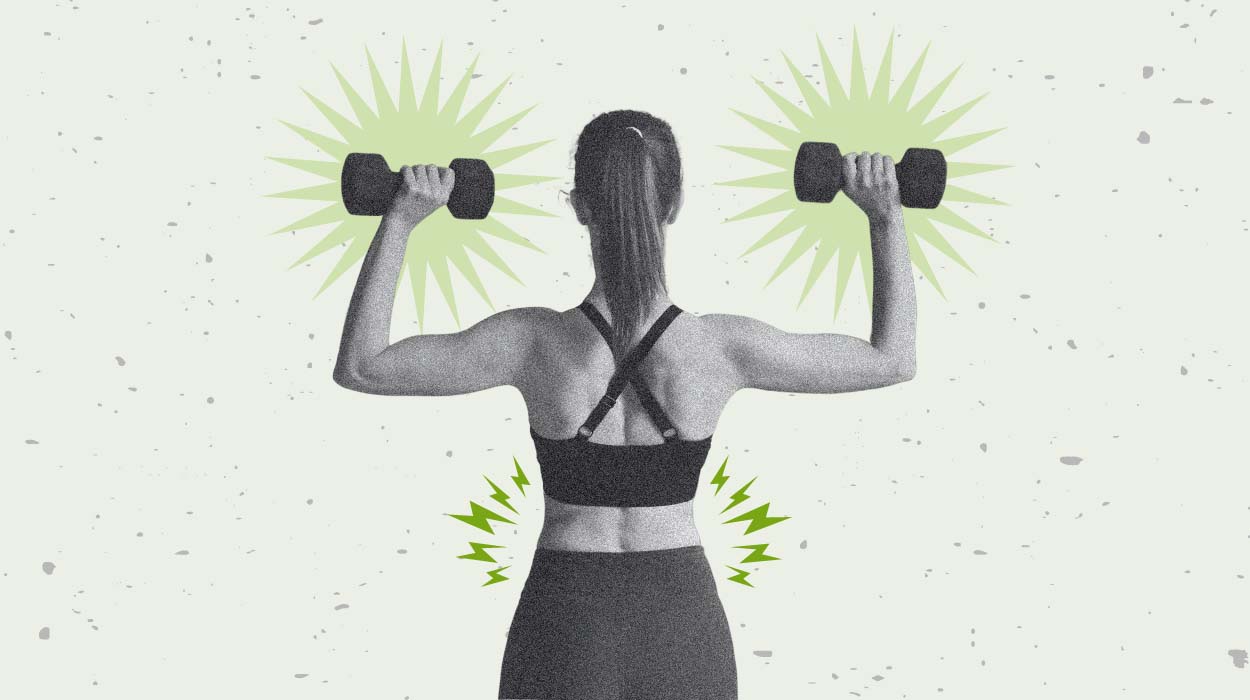
Building a bigger and stronger back is important for many reasons. It helps improve posture,[1] creates wider shoulders and a smaller waist, and supports shoulder health. There are many muscles in your back and making sure to strengthen all of them takes effort and concentration.
The main upper back muscles to be aware of include the trapezius, rhomboid, and rear deltoids. Moving down the back there is the latissimus dorsi and in the lower back resides the quadratus lumborum. With these exercises, you’ll be able to strengthen all parts of your back using only dumbbells.
Best Back Exercises With Dumbbells
To Build Muscles
- Single-Arm Dumbbell Row
- Chest Supported Dumbbell Row
- Dumbbell Seal Row
- Bent Over Dumbbell Row
- Dumbbell Pullover
- Dumbbell Shrug
- Dumbbell Upright Row
To Improve Posture
Best Dumbbell Back Exercises
By implementing these dumbbell back exercises, you can target the majority of the muscle groups in your back to improve strength and posture. Some of these exercises include variations in rows, dumbbell pullovers, shrugs, I/T/W on your stomach, and Superman. It is important to follow the instructions for proper form to avoid injury and ensure proper muscle activation. Performing these exercises can help decrease your risk of low back pain[2] and better support your body during everyday movements.
Single-Arm Dumbbell Row
This exercise effectively targets the muscles of the upper back, including the lats, rhomboids, and traps, while also engaging the biceps and core for stability. Incorporating Single-Arm Dumbbell Rows can help you improve posture, build a well-defined back, and enhance overall upper body strength. Additionally, this exercise allows you to address any muscle imbalances between your left and right sides, making it a functional and beneficial choice for a comprehensive back workout routine.
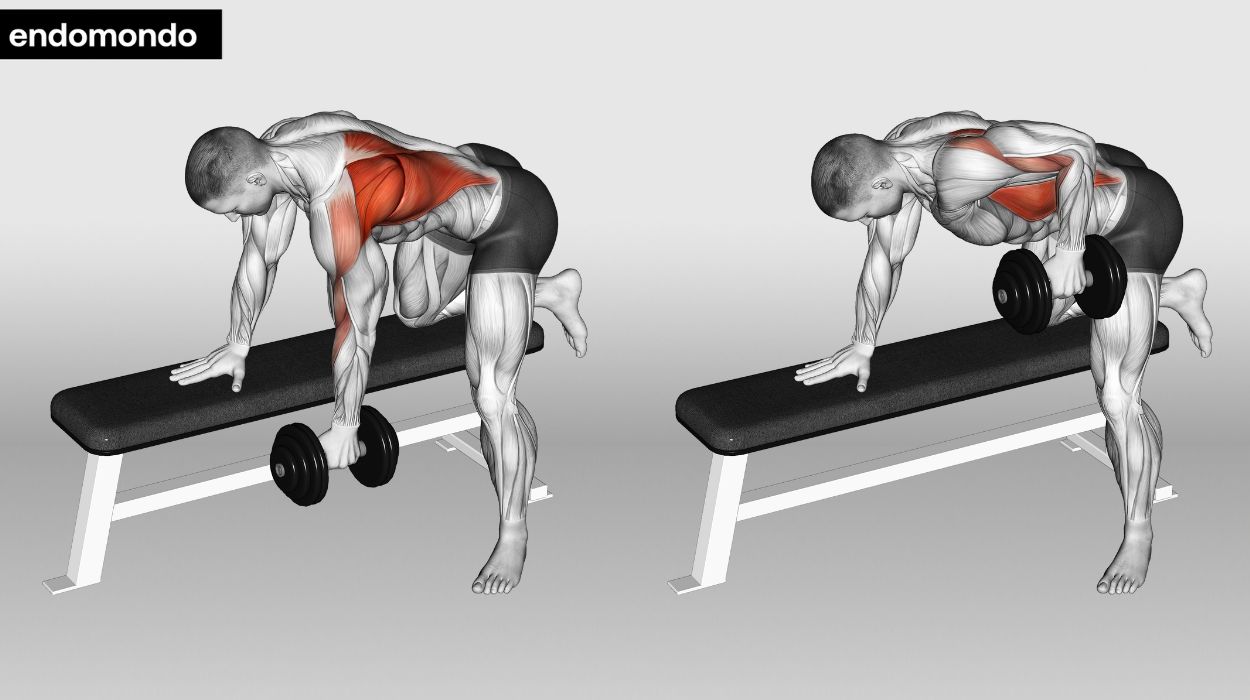
How to do:
- Stand with one knee and hand on a bench, holding a dumbbell in the opposite hand.
- Keep your back straight, engage your core, and let the dumbbell hang at arm’s length.
- Lift the dumbbell towards your hip, keeping your elbow close to your body.
- Squeeze your shoulder blade at the top, then lower the weight with control. Repeat.
Tips:
- Stand with one foot in front of the other, knees slightly bent, and your back straight. This stable base supports proper form and balance during the exercise.
- Keep your core muscles engaged to stabilize your spine and prevent excessive twisting or swaying while rowing the dumbbell.
- Pull the dumbbell towards your hip while squeezing your shoulder blade. Extend your arm fully during the eccentric phase for optimal muscle engagement and development.
Optimal Sets and Reps: 3 sets of 10-12 reps.
Chest Supported Dumbbell Row
This exercise effectively targets the muscles of the upper and middle back, including the latissimus dorsi and rhomboids, while also engaging the biceps. By performing rows with chest support, you reduce the risk of lower back strain and can focus solely on isolating and strengthening the back muscles. Incorporating this exercise into your routine contributes to improved posture, enhanced upper body strength, and a well-defined back, making it an essential element of a comprehensive back workout.
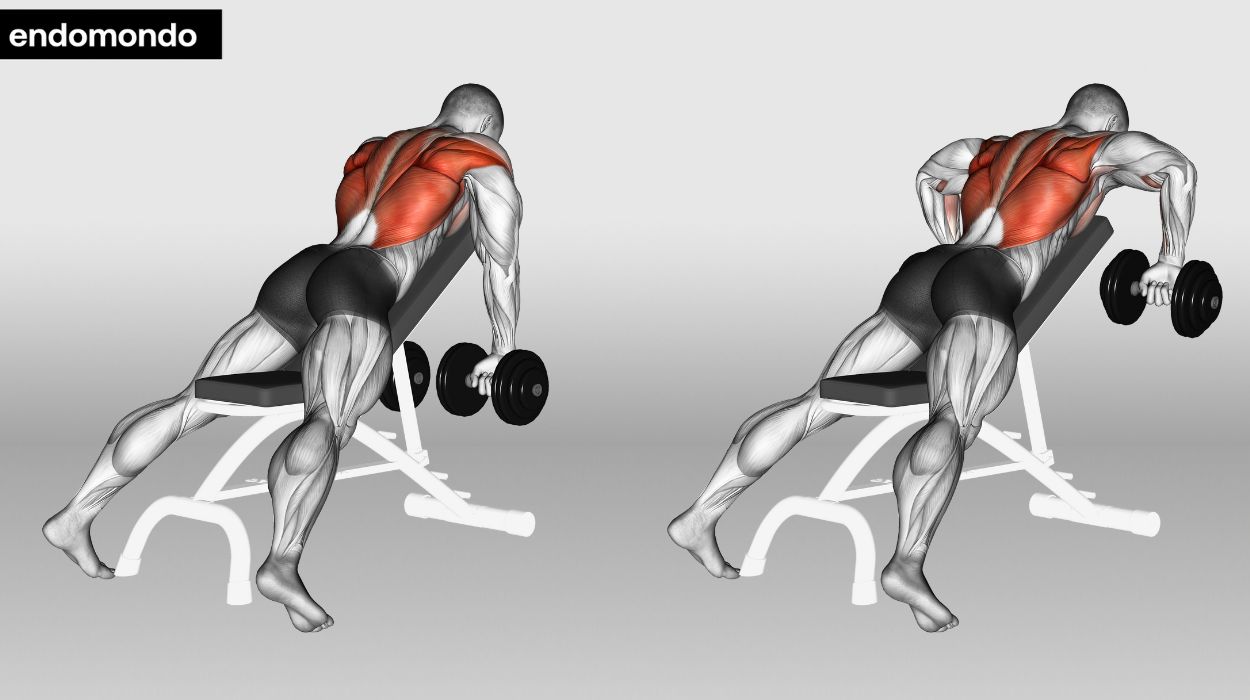
How to do:
- Set an incline bench at a 45-degree angle.
- Lie face down, chest on the bench.
- Hold dumbbells, row upwards, and squeeze shoulder blades.
- Lower weights with control.
Tips:
- Keep your chest pressed against the bench and your back straight throughout the exercise. Focus on pulling the dumbbells towards your hips with a controlled motion to engage your upper back muscles effectively.
- Use a weight that challenges you but allows you to perform each repetition with good form. Avoid excessive swinging or jerking movements to minimize the risk of injury.
- At the top of each row, squeeze your shoulder blades together for a moment to maximize muscle engagement before lowering the dumbbells back down. This enhances the effectiveness of the exercise for building a strong and well-defined back.
Optimal Sets and Reps: 3 sets of 10-12 reps.
Dumbbell Seal Row
This exercise effectively targets the upper back, lats, and rear deltoids while promoting improved posture. It engages multiple muscle groups, enhancing overall back strength and muscle definition. Additionally, Dumbbell Seal Rows can help prevent imbalances in the back and shoulders, leading to a more balanced and well-developed upper body. This exercise variation adds diversity to your back workout routine, contributing to better results and a stronger, more sculpted back.
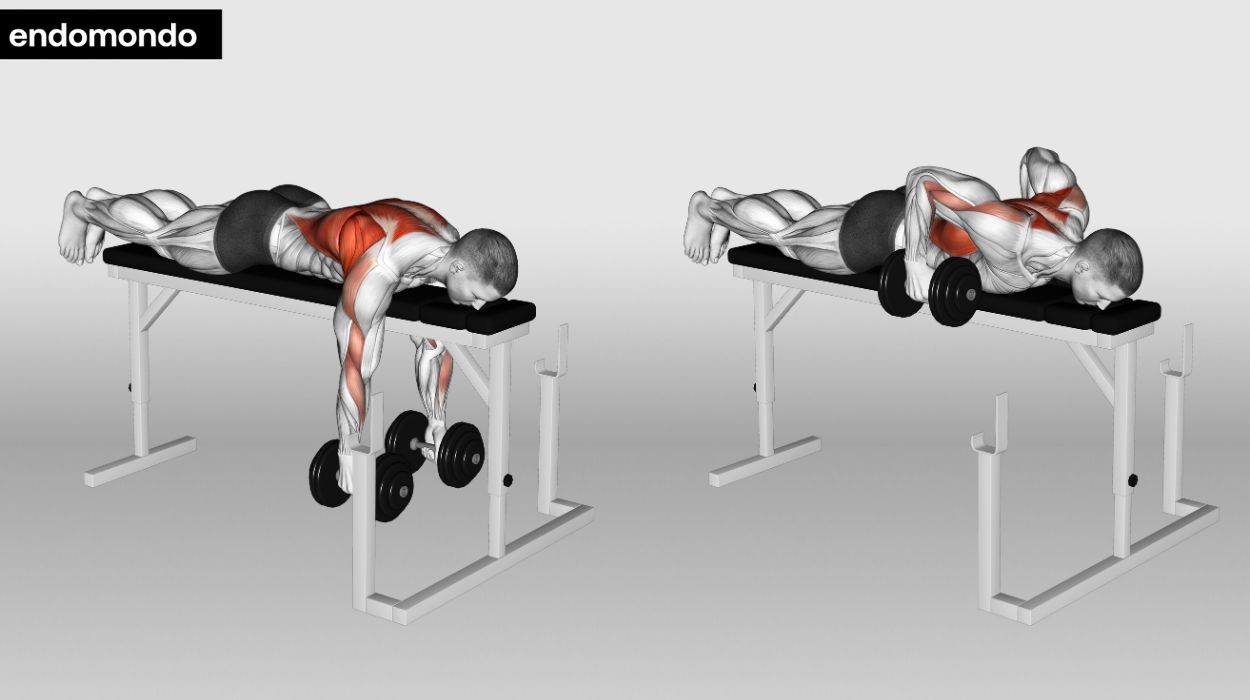
How to do:
- Place two dumbbells parallel to each other on the floor, and lie face down between them.
- Reach down and grasp the dumbbells with a neutral grip.
- Retract your shoulder blades, lift the dumbbells, and squeeze your back muscles.
- Lower the dumbbells back down to the floor in a controlled manner.
- Perform the desired number of repetitions for a powerful back workout.
Tips:
- Ensure your bench is positioned at the right height to allow your arms to fully extend and retract during the exercise. This optimizes the range of motion and muscle engagement.
- Keep your back flat and chest against the bench throughout the movement. Avoid rounding or arching your spine to prevent injury and maximize the effectiveness of the exercise.
- Concentrate on squeezing your shoulder blades together at the top of each repetition to engage your upper back muscles fully. This contraction is key to building strength and definition in the upper back.
Optimal Sets and Reps: 3 sets of 10-12 reps.
Bent Over Dumbbell Row
This compound exercise primarily targets the lats, rhomboids, and traps, helping to improve upper body strength and posture. By using dumbbells, you can also address any muscle imbalances and engage your stabilizing muscles for a more comprehensive workout. Bent Over Dumbbell Rows contribute to enhanced back muscle development, better posture, and overall upper body strength, making them a valuable addition to any back-focused fitness routine.
This compound exercise primarily targets the lats, rhomboids, and traps, helping to improve upper body strength and posture. By using dumbbells, you can also address any muscle imbalances and engage your stabilizing muscles for a more comprehensive workout. Bent Over Dumbbell Rows contribute to enhanced back muscle development, better posture, and overall upper body strength, making them a valuable addition to any back-focused fitness routine.
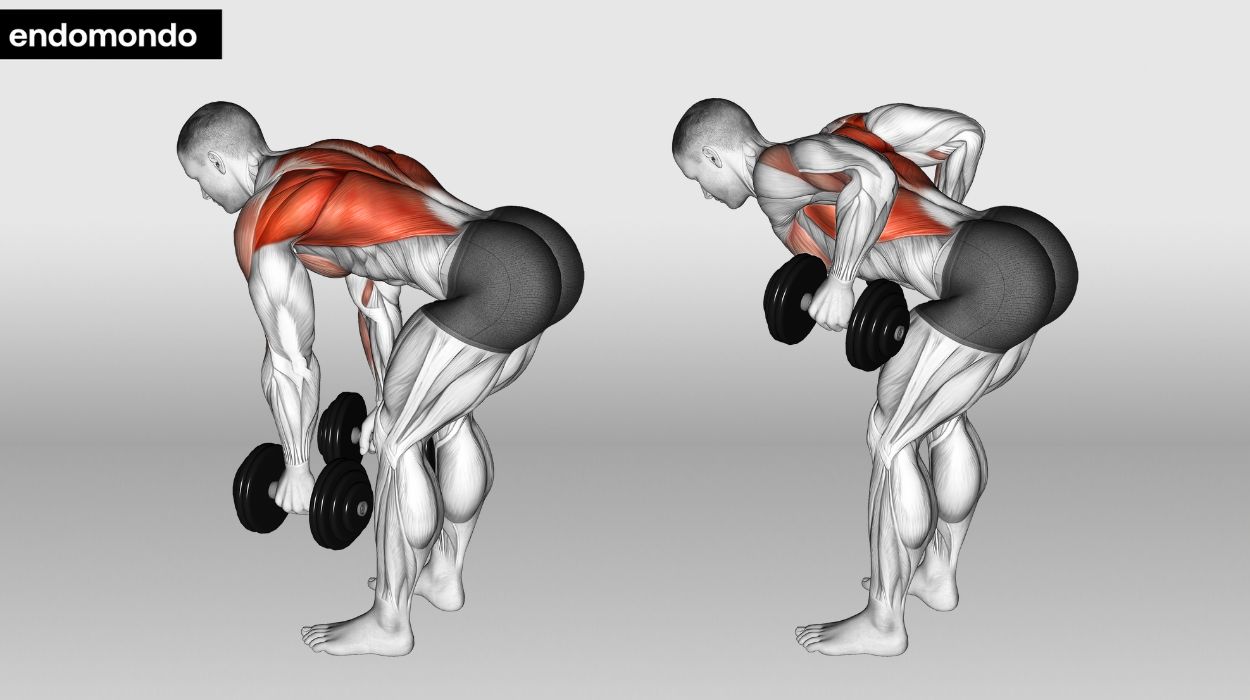
How to do:
- Stand with feet shoulder-width apart, hold a dumbbell in each hand, palms facing your body.
- Bend at your hips, keeping your back straight, and lower your torso to a 45-degree angle.
- Pull the dumbbells towards your hips, squeezing your shoulder blades together.
- Lower the weights back down, keeping your core engaged, and repeat.
Tips:
- Keep your back flat, chest up, and core engaged to support your lower back while bending at the hips. This ensures proper form and minimizes the risk of injury.
- As you pull the dumbbells towards your hips, squeeze your shoulder blades together to engage the target muscles effectively.
- Lower the dumbbells slowly and with control, emphasizing the eccentric phase of the movement. This maximizes muscle engagement and minimizes momentum.
Optimal Sets and Reps: 3 sets of 10-12 reps.
Dumbbell Pullover
This exercise primarily targets the latissimus dorsi (lats) while engaging the chest and triceps. It enhances back width and ribcage expansion, providing a V-taper appearance. Additionally, Dumbbell Pullovers contribute to improved shoulder mobility and flexibility, making it a valuable addition to your back training routine for a well-rounded, strong, and sculpted upper body.
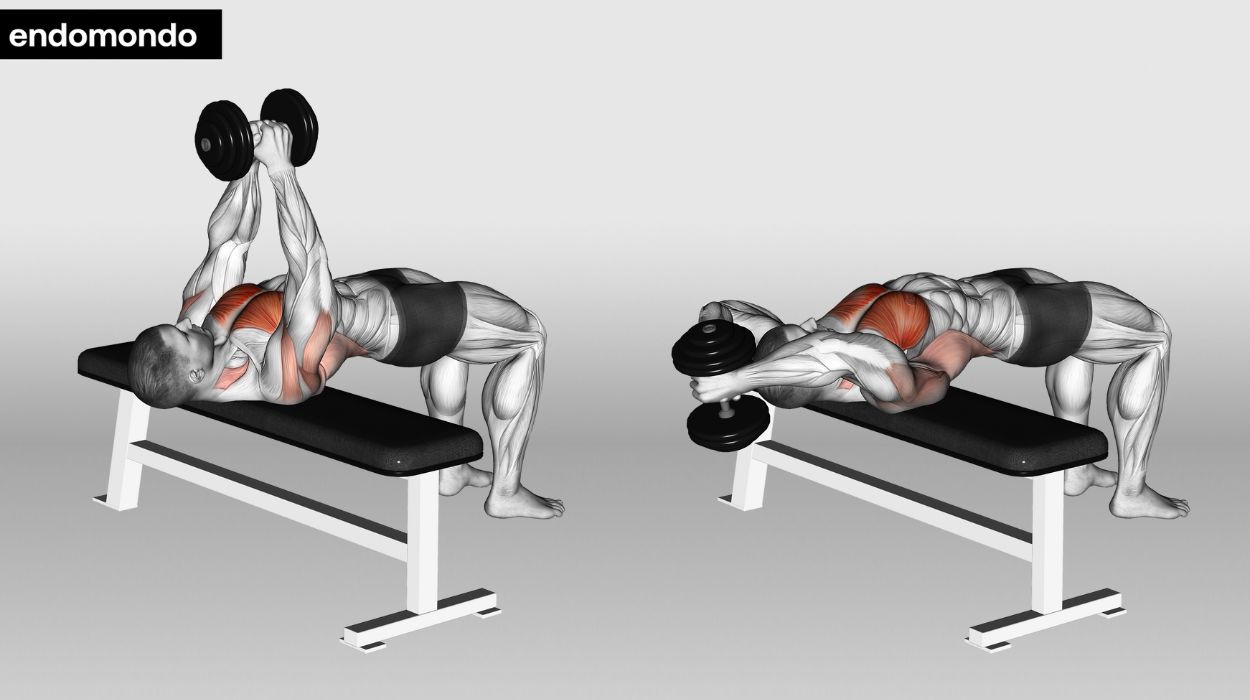
How to do:
- Lie on a bench horizontally.
- Hold a dumbbell with both hands overhead.
- Lower dumbbell behind head.
- Raise it back to start and repeat.
Tips:
- Keep your core engaged and your back flat against the bench throughout the exercise to avoid straining your lower back. Maintain a slight bend in your elbows to prevent unnecessary stress on the joints.
- Focus on the eccentric (lowering) phase of the movement, controlling the weight as you bring it back over your head. This ensures proper muscle engagement and minimizes the risk of injury.
- Inhale as you lower the dumbbell and exhale as you bring it back up. Proper breathing helps maintain stability and control during the Dumbbell Pullover.
Optimal Sets and Reps: 3 sets of 10-12 reps.
Dumbbell Shrug
This exercise primarily targets the trapezius muscles, helping you build upper back strength and enhance shoulder stability. Dumbbell Shrugs also improve posture and can contribute to a more sculpted and defined back appearance. By including this exercise, you can achieve a well-rounded and balanced back workout, ultimately enhancing your overall upper body strength and aesthetics.
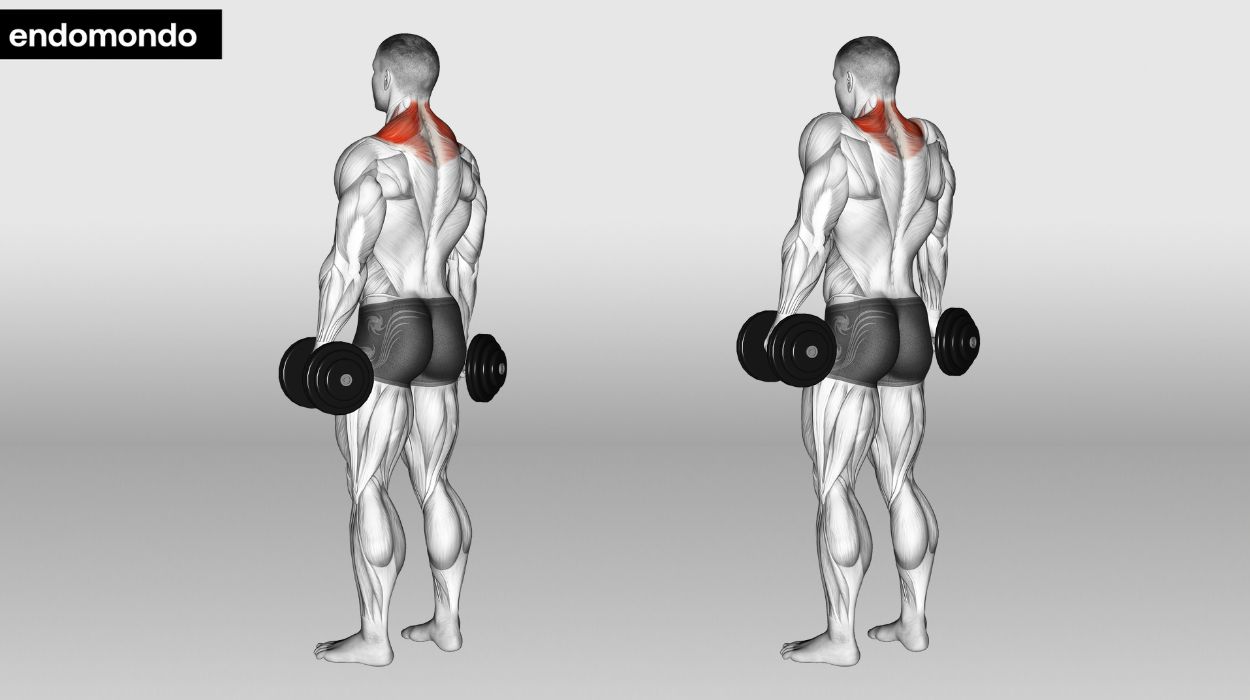
How to do:
- Stand with feet shoulder-width apart, holding dumbbells in both hands by your sides.
- Elevate your shoulders towards your ears, and hold for a second.
- Lower the dumbbells and repeat.
Tips:
- Stand with your feet shoulder-width apart, keeping your back straight and shoulders relaxed. Lift the dumbbells by shrugging your shoulders straight up towards your ears, avoiding rolling them forward or backward.
- Lift and lower the dumbbells in a slow and controlled manner, focusing on the contraction of your trapezius muscles at the top of the movement. Avoid using excessive momentum or jerking motions.
- Inhale as you lower the dumbbells and exhale as you lift them, maintaining a consistent and controlled breathing pattern throughout the exercise.
Optimal Sets and Reps: 3 sets of 10-15 reps.
Dumbbell Upright Row
This exercise primarily targets the upper back and shoulder muscles, including the traps and deltoids. It helps improve posture, enhances shoulder strength and stability, and contributes to a well-rounded back development. Dumbbell Upright Rows also engage the biceps, making them a valuable addition to your back workout routine. By targeting multiple muscle groups simultaneously, you can efficiently build strength and definition in your upper body while promoting better overall posture and functionality.
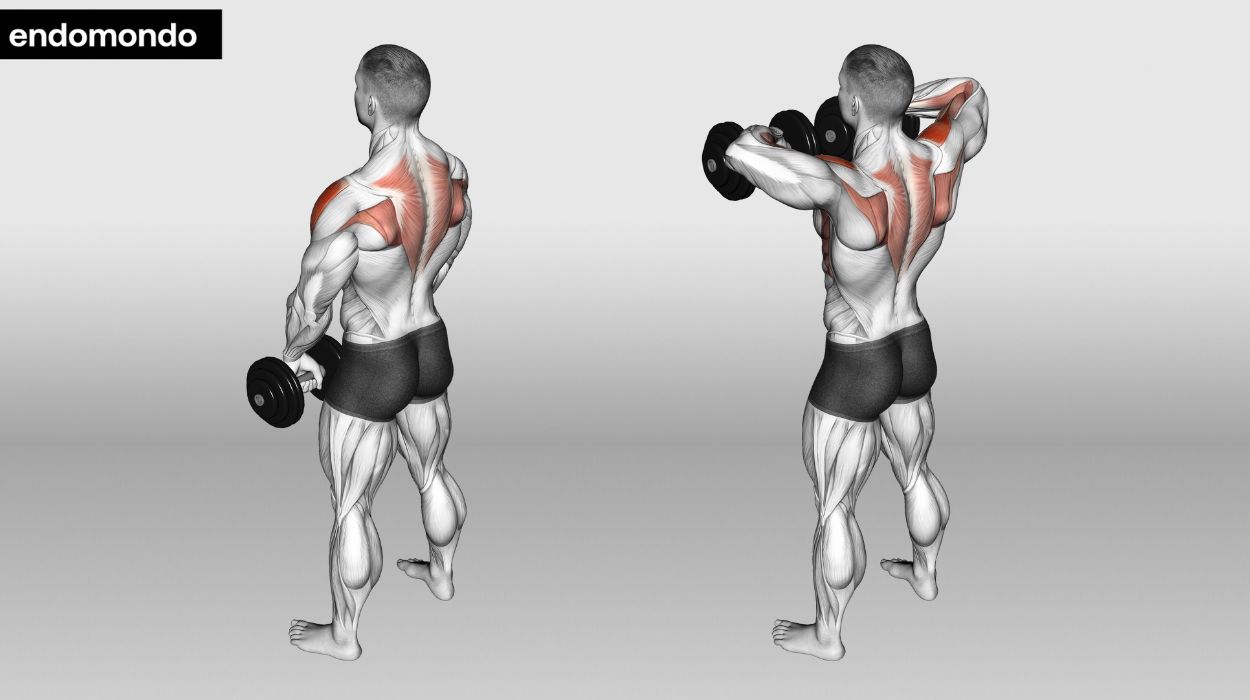
How to do:
- Stand with feet hip-width apart, holding a dumbbell in each hand, arms fully extended.
- Lift dumbbells toward your chin, keeping your elbows higher than your wrists.
- Lower weights back down and repeat. Avoid excessive momentum.
Tips:
- Hold the dumbbells shoulder-width apart, keeping a firm grip. Maintain an upright posture, retract your shoulder blades, and engage your core to prevent excessive stress on the shoulders and lower back.
- Keep your elbows slightly higher than your hands throughout the movement, pulling the dumbbells toward your chin. Avoid excessive elevation, which can lead to shoulder strain.
- Lift the weights smoothly with control, and lower them back down at a moderate pace. Avoid jerky movements to reduce the risk of injury and maximize muscle engagement in your upper back.
Optimal Sets and Reps: 3 sets of 10-12 reps.
Renegade Rows
This exercise not only strengthens your back muscles but also engages your core, shoulders, and arms. It enhances overall upper body stability and posture, making it valuable for preventing injuries and improving functional strength. Renegade Rows promote balanced muscle development and can help you achieve a more defined and sculpted back, making them an excellent choice for a comprehensive upper body workout routine.
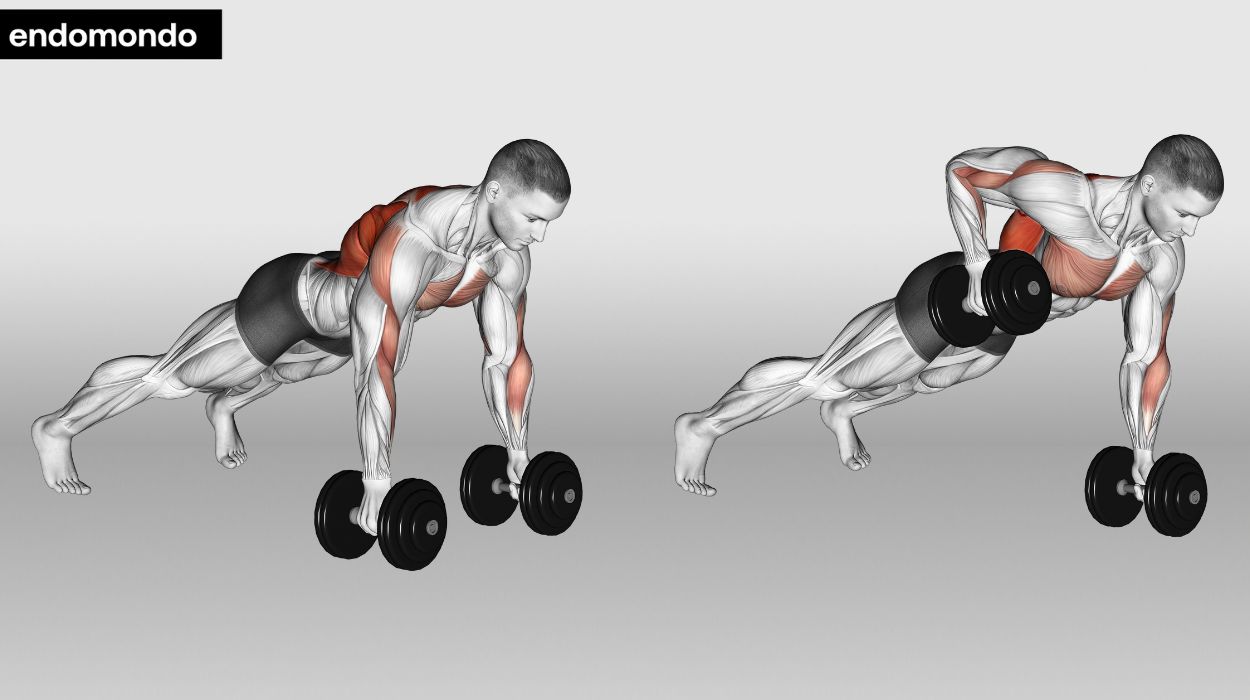
How to do:
- Begin in a plank position with a dumbbell in each hand.
- Row one dumbbell to your hip while stabilizing with the other.
- Alternate sides, engaging your core and maintaining a straight back.
Tips:
- Begin in a strong plank position with your wrists directly under your shoulders and your body in a straight line from head to heels. This stability is crucial for executing Renegade Rows safely and effectively.
- Lift one dumbbell at a time while stabilizing your body with the opposite arm. Keep your core tight and hips square to the ground to prevent excessive rotation.
- Focus on controlled movements when rowing the dumbbells, squeezing your back muscles at the top of each row. Avoid using momentum, which can reduce the effectiveness of the exercise and increase the risk of injury.
Optimal Sets and Reps: 3 sets of 10-12 reps.
I/T/W’s
These exercises target the muscles of the upper back, including the trapezius and rhomboids, promoting improved posture, enhanced shoulder stability, and a well-defined back. The I/T/W sequence engages multiple muscle fibers and helps balance strength throughout the upper back. By incorporating these variations, you can create a more comprehensive and effective back workout routine that contributes to better overall upper body strength and aesthetics.
How to do:
- Lie face-down on an exercise bench, feet hanging off the edge, holding dumbbells in each hand.
- Lift your arms in a straight line to form an ‘I’ shape.
- Lower your arms and create a ‘T’ shape with your body.
- Return to the starting position, forming a ‘W’ shape with your elbows bent.
- Repeat while maintaining proper form and control.
Tips:
- Focus on engaging your back muscles throughout the exercise, not just moving your arms. Squeeze your shoulder blades together to activate the upper back effectively.
- Keep the movements slow and controlled, especially in the ‘T’ and ‘W’ positions. This maximizes muscle engagement and minimizes the risk of injury.
- Maintain a neutral spine and avoid arching your back during the exercise. Proper form is crucial for targeting the intended muscle groups effectively.
Optimal Sets and Reps: 3 sets of 10-12 reps.
Supermans
Incorporating Supermans into a Dumbbell Back workout offers an excellent way to strengthen the lower back, engage the erector spinal muscles, and improve posture. This bodyweight exercise helps counterbalance the focus on larger back muscles during dumbbell workouts, promoting balance and stability in the entire back region. Supermans also enhance spinal extension, which can alleviate lower back discomfort and contribute to a well-rounded and injury-resistant back.
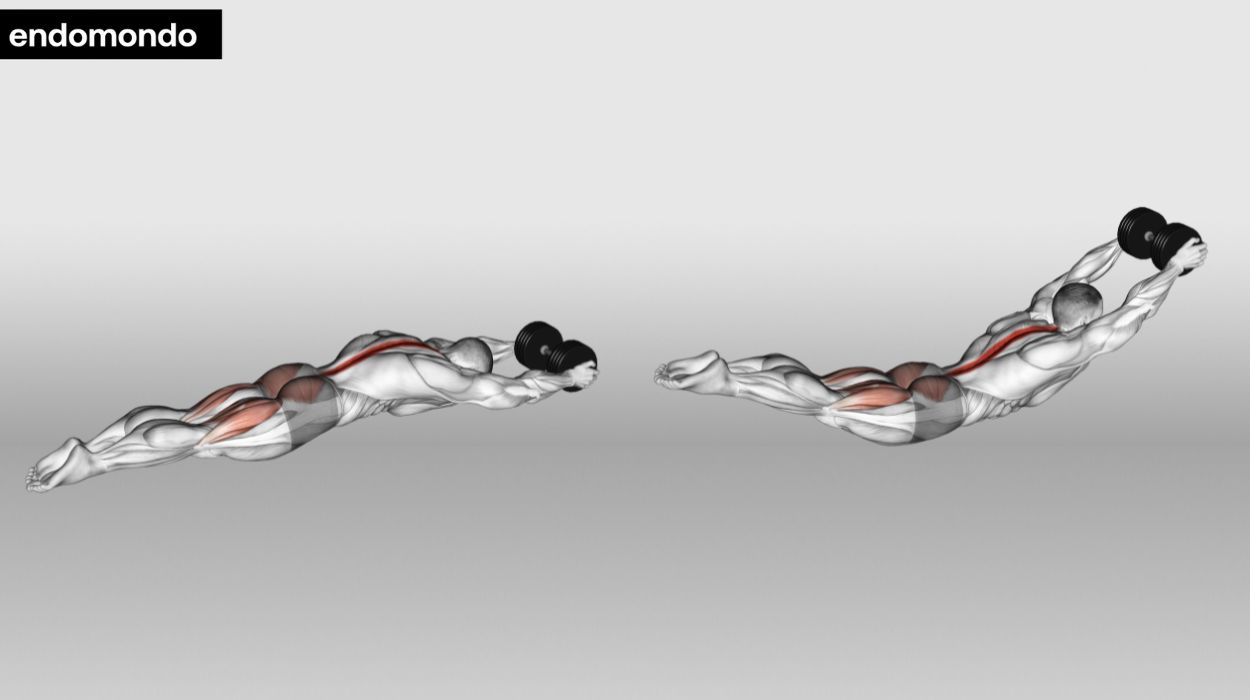
How to do:
- The starting position is flat on your stomach on the floor with your light dumbbells in each hand.
- Your arms extended out to the sides and your legs straight.
- Using your back, pull all four limbs off the ground at the same time then slowly lower.
- You may keep your elbows slightly bent. This will target traps, rhomboids, rear delts, and quadratus lumborum.
Tips:
- Maintain a neutral neck position and lift your chest and legs off the ground simultaneously, engaging your lower back muscles. Avoid straining your neck by keeping it in line with your spine.
- At the top of the movement, squeeze your lower back muscles and hold for a brief moment to maximize muscle engagement before lowering back down.
- Exhale as you lift, and inhale as you lower down. Perform the exercise in a slow and controlled manner to prevent any jerking or momentum.
Optimal Sets and Reps: 3 sets of 10-15 reps.
Benefits Of Dumbbell Back Workouts
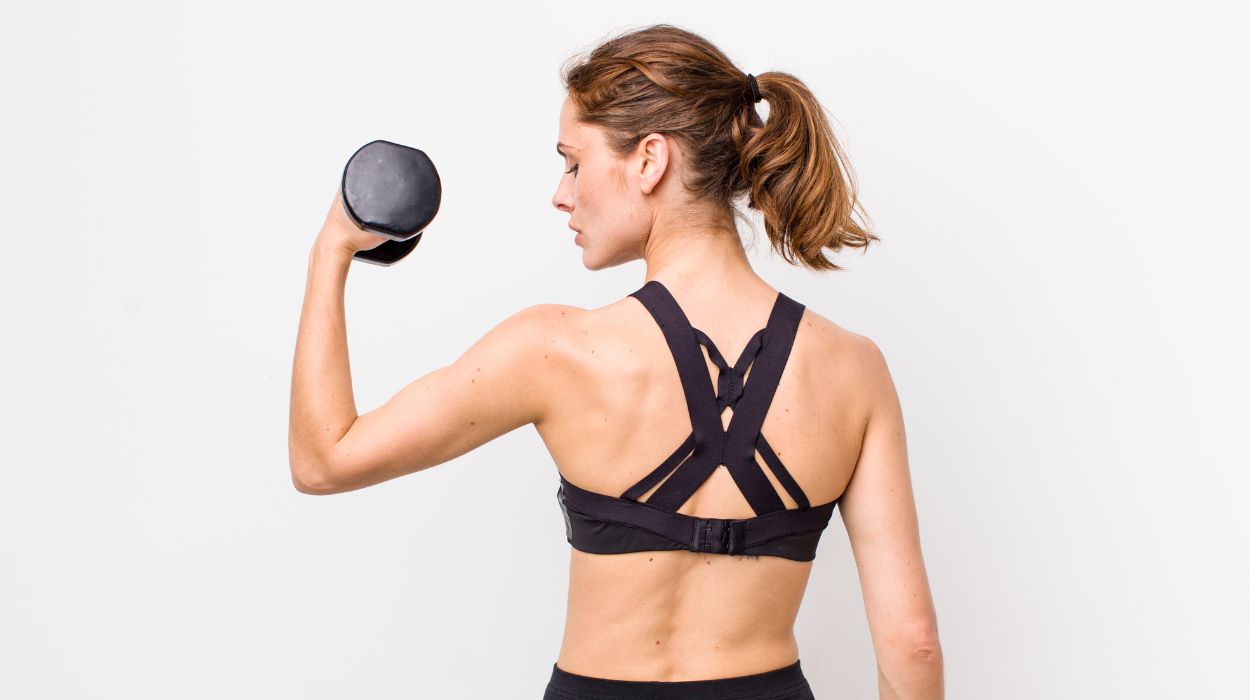
The main benefit of a dumbbell workout to strengthen your back is that you can do it anywhere. You don’t need the large machines (although they work great and are beneficial) to make the gains you desire. Dumbbells are relatively small and you can store them at home. Having a variety of weights is important so you can increase your load over time and continue to gain strength.
Resistance training is one of the best ways to fight chronic low back pain.[3] By strengthening our muscles, we are giving them the capacity to support the joints that they surround. Our spine has tons of joints throughout it so building and maintaining strength decreases the chance that those joints become irritated and inflamed. Weight training can also help you lose weight by boosting your metabolism.[4] Bigger, stronger muscles require more energy to maintain their baseline function, therefore burning more calories.
Tips For Doing Back Workouts
Proper Nutrition
Eat a healthy breakfast to give you the energy needed to fuel your workout. This should include some form of carbohydrates and protein.
Have A Plan
Planning your workout can reduce stress and time spent wandering around. Keep a journal or a note on your phone with the workout and track your progress by writing how much weight you use and how many sets and reps you perform.
Listen To Your Body
Be aware of how your exercises feel. If something feels painful, ask a personal trainer or physical therapist to help you with your form and to make sure you have the range of motion necessary for these movements.
Conclusion
Using free weights for an entire workout can simplify your routine. By including some of these exercises in your workouts, you’ll be able to strengthen all of the most important back muscles.
Paying close attention to nutrition and creating a structured plan for diet and exercise routine, can also help you reach your goals and improve your overall physique. Be sure to consult a medical professional including a personal trainer or physical therapist if you have questions regarding lifting techniques and or desire further guidance before implementing a new workout routine.
Frequently Asked Questions
Heavier weights will build bigger muscles and lighter weights should be used for endurance or postural exercises.
One to two times per week for best results.
Trapezius, rhomboids, rear deltoids, latissimus dorsi and quadratus lumborum.
Resources
- Su Su Hlaing, Rungthip Puntumetakul, Ei Ei Khine and Boucaut, R. (2021). Effects of core stabilization exercise and strengthening exercise on proprioception, balance, muscle thickness and pain related outcomes in patients with subacute nonspecific low back pain: a randomized controlled trial. BMC Musculoskeletal Disorders, [online] 22(1). doi:https://doi.org/10.1186/s12891-021-04858-6.
- Atalay, E., Akova, B., Gür, H. and Sekir, U. (2017). Effect of Upper-Extremity Strengthening Exercises on the Lumbar Strength, Disability and Pain of Patients with Chronic Low Back Pain: A Randomized Controlled Study. Journal of sports science & medicine, [online] 16(4), pp.595–603. Available at: https://www.ncbi.nlm.nih.gov/pmc/articles/PMC5721192/.
- Tataryn, N., Simas, V., Catterall, T., Furness, J. and Keogh, J.W.L. (2021). Posterior-Chain Resistance Training Compared to General Exercise and Walking Programmes for the Treatment of Chronic Low Back Pain in the General Population: A Systematic Review and Meta-Analysis. Sports Medicine – Open, [online] 7(1). doi:https://doi.org/10.1186/s40798-021-00306-w.
- Westcott, W.L. (2012). Resistance Training is Medicine. Current Sports Medicine Reports, [online] 11(4), pp.209–216. doi:https://doi.org/10.1249/jsr.0b013e31825dabb8.




